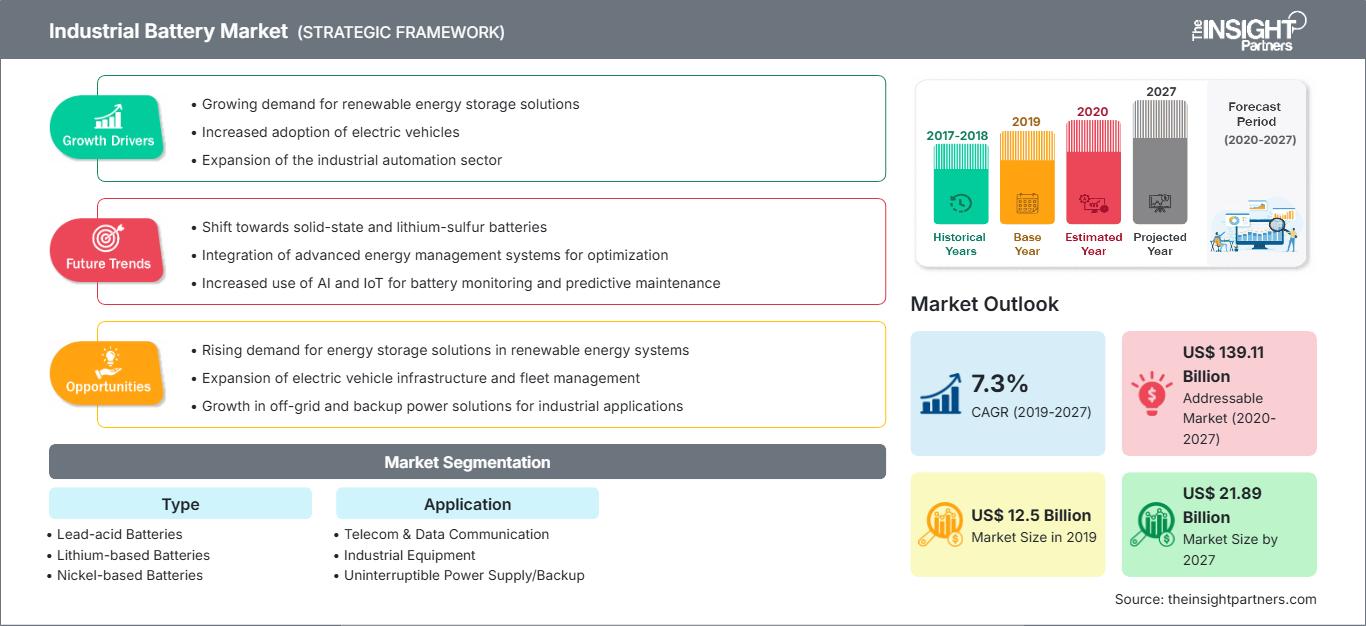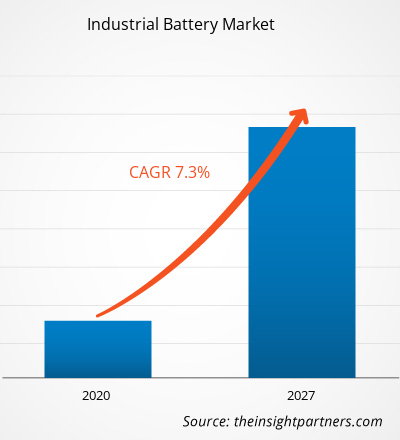2019 年工业电池市场价值为 125.019 亿美元,预计 2020 年至 2027 年的复合年增长率为 7.3%,到 2027 年将达到 218.935 亿美元。
工业电池是经过特殊设计的电池,可以在极端温度、更多振动和频繁使用等恶劣的工业温度下运行。工业电池性能更佳,设计更强大。在目前的市场形势下,各公司正在努力开发高效电池,以满足各种工业电池需求。预计全球工业电池市场在预测期内将出现令人瞩目的增长。预计在预测期内,对锂电池的需求将大幅增长。由于锂电池具有低排放、更长的使用寿命和可回收性等优势,预计其在各个垂直领域的应用都将增长。在市场上运营的公司正专注于开发新产品,以赢得强大的客户群并获得可观的市场份额。
北美国家(例如美国)的政府正在不断采取措施提高制造业的生产力。例如,提供最新技术以简化制造流程并增加仓库数量。预计这些仓库中自动化技术的使用将影响北美工业电池市场的增长。政府增加的支出将推动任何技术的发展。在北美地区,政府在技术进步活动上的支出相当高,这为任何企业的蓬勃发展创造了有利的环境。物联网、大数据和先进技术在该地区得到了广泛的应用。这些技术反过来又推动了增强型网络的需求以及对工业电池的需求。工业电池市场中的一些新兴技术包括新一代锂离子 (Li-ion) 电池、锂硫电池、固态电池、铝离子电池等。
自定义此报告以满足您的要求
您将免费获得任何报告的定制,包括本报告的部分内容,或国家级分析、Excel 数据包,以及为初创企业和大学提供超值优惠和折扣
工业电池市场: 战略洞察

- 获取本报告的主要市场趋势。这个免费样本将包括数据分析,从市场趋势到估计和预测。
市场洞察:并网不间断电源解决方案推动工业电池需求
您将免费获得任何报告的定制,包括本报告的部分内容,或国家级分析、Excel 数据包,以及为初创企业和大学提供超值优惠和折扣
工业电池市场: 战略洞察

- 获取本报告的主要市场趋势。这个免费样本将包括数据分析,从市场趋势到估计和预测。
最突出和最重要的可再生能源类型是太阳能和风能,它们被储存在电网中。然而,云层遮挡阳光或风流波动可能会导致发电过程发生变化。这些变化催生了对用于储能的灵活电网系统的需求。工业电池储能系统帮助电网运营商在用电量超过用电需求时节省电力。因此,这些系统的广泛应用有助于提高电力供应系统在发电、输电和配电方面的可靠性和灵活性。在输电和配电过程中,电池储能系统可以处理资产延期、谐波抑制、电压支持、频率调节和电能质量等多个方面。电能时移、可再生能源时移、基荷均衡和调峰以及可再生能源容量稳定是使用电池储能系统进行并网解决方案的其他优势,这些优势推动了这些系统的普及,从而推动了工业电池市场的增长。市场参与者正在推出新的电网解决方案,以在工业电池市场保持竞争优势。例如,西门子推出了智能电网解决方案SIESTORAGE。SIESTORAGE能够克服电力供应三个主要方面面临的挑战,即优化电网连接、为现代电网提供弹性能源以及支持大型能源消费者。此外,2015年7月,EDP Distribuicao向西门子位于葡萄牙埃沃拉的SIESTORAGE发出了Storage InovGrid招标。SIESTORAGE系统提供电压调节、能源备份和调峰等服务,以保障EDP的电网稳定,并将智能电网的优势复制到电网运营商身上。
类型洞察
在类型细分领域,铅酸电池在全球工业电池市场占据最大份额。铅酸电池成本低、性能高,易于回收,充电便捷。铅酸电池因其成本低、使用寿命长而得到广泛应用。然而,这种电池不适合持续高负载;此外,它的体积能量密度相对较低,这使得它们在能源管理应用中不太可行;因此,它主要用于电力应用。这种电池的改进仍在进行中,这可能会使其成为能源管理更可行的选择。
应用洞察
工业电池市场按应用细分为电信和数据通信、工业设备、不间断电源 (UPS)/备用电源、采矿、船舶等。工业设备领域在全球工业电池市场占据主导地位。物联网、人工智能 (AI)、大数据分析、网络通信、云计算和机器学习技术等日益发展的工业 4.0 趋势,标志着企业工作方式及其与客户互动方式的重大变革。这些不断发展的技术正在提供创新的工业设备解决方案,以支持高效设备的生产和交付。
企业通常采用并购策略来扩大其全球业务范围并满足不断增长的需求。这种策略主要在北美和欧洲实施。工业电池市场的参与者采用扩张和投资研发的策略来扩大全球客户群,这也使参与者能够在全球范围内维护其品牌名称。以下列出了最近的一些收购:
2019 年:East Penn 宣布收购 Navitas Systems 的多数股权。预计此次收购将支持 Motive Power 电池产品的扩展。2019 年:Saft 宣布收购 Go Electric Inc. 100% 的股份,Go Electric Inc. 是一家总部位于美国的开发商,为微电网和商业及工业客户提供分布式能源弹性解决方案。
工业电池市场
The Insight Partners 的分析师已详尽阐述了预测期内影响工业电池市场的区域趋势和因素。本节还讨论了北美、欧洲、亚太地区、中东和非洲以及南美和中美洲的工业电池市场细分和地域分布。
工业电池市场报告范围
| 报告属性 | 细节 |
|---|---|
| 市场规模 2019 | US$ 12.5 Billion |
| 市场规模 2027 | US$ 21.89 Billion |
| 全球复合年增长率 (2019 - 2027) | 7.3% |
| 历史数据 | 2017-2018 |
| 预测期 | 2020-2027 |
| 涵盖的领域 |
By 类型
|
| 覆盖地区和国家 | 北美
|
| 市场领导者和主要公司简介 |
|
工业电池市场参与者密度:了解其对业务动态的影响
工业电池市场正在快速增长,这得益于终端用户需求的不断增长,而这些需求的驱动因素包括消费者偏好的不断变化、技术进步以及对产品优势的认知度不断提高。随着需求的增长,企业正在扩展产品线,不断创新以满足消费者需求,并抓住新兴趋势,从而进一步推动市场增长。

- 获取 工业电池市场 主要参与者概述
- 铅酸电池
- 锂电池
- 镍基电池
- 其他
工业电池市场 — 按应用
- 电信和数据通信
- 工业设备
- UPS /备用电源
- 电网级储能
- 采矿
- 船舶
- 其他
全球工业电池市场(按地区)
北美
- 美国
- 加拿大
- 墨西哥
欧洲
- 法国
- 德国
- 意大利
- 英国
- 俄罗斯
- 欧洲其他地区
亚太地区
- 中国
- 印度
- 韩国
- 日本
- 澳大利亚
- 亚太其他地区
中东和非洲
- 南非
- 沙特阿拉伯
- 阿联酋
- 中东和非洲其他地区
南美洲
- 巴西
- 阿根廷
- 南美洲其他地区
公司简介
- C&D Technologies, Inc.
- East Penn Manufacturing Company
- EnerSys
- Exide Industries Limited
- 通用电气公司
- GS Yuasa International Ltd.
- LG Chem
- 松下公司
- Robert Bosch GmbH
- Saft Groupe SA
- 历史分析(2 年)、基准年、预测(7 年)及复合年增长率
- PEST和SWOT分析
- 市场规模、价值/数量 - 全球、区域、国家
- 行业和竞争格局
- Excel 数据集
近期报告
相关报告
客户评价
购买理由
- 明智的决策
- 了解市场动态
- 竞争分析
- 客户洞察
- 市场预测
- 风险规避
- 战略规划
- 投资论证
- 识别新兴市场
- 优化营销策略
- 提升运营效率
- 顺应监管趋势




















 获取免费样品 - 工业电池市场
获取免费样品 - 工业电池市场